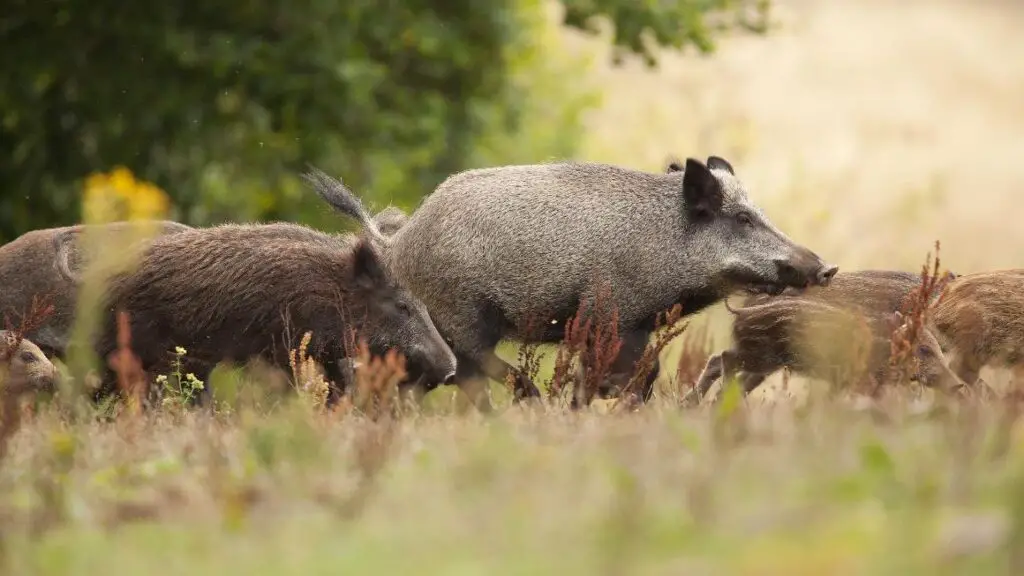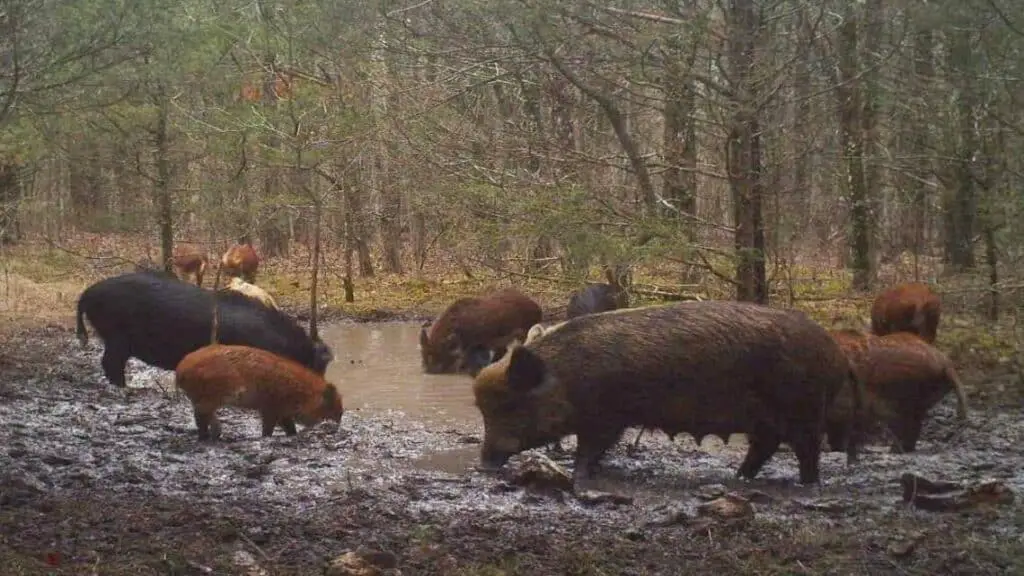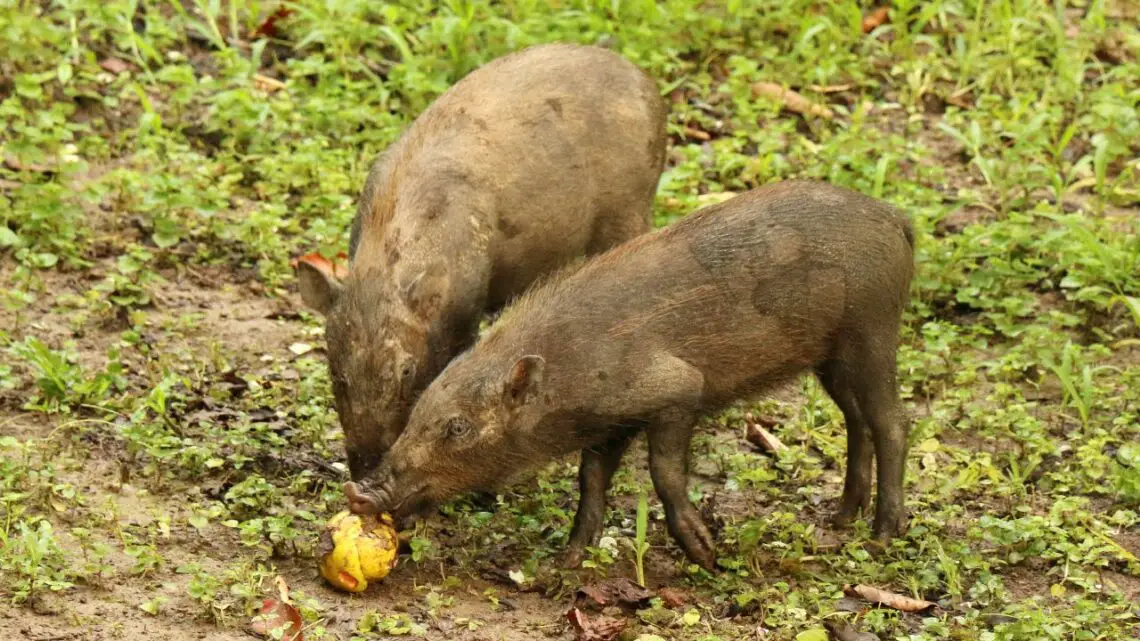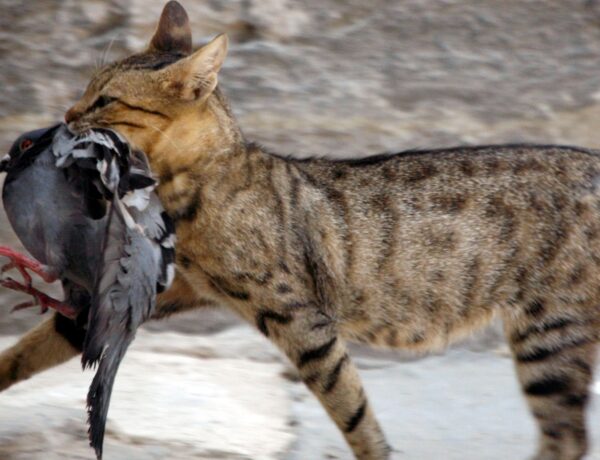Introduction
What Do Wild Pigs Eat: Wild boars eat a diet that consists of plants, vegetables, insects, and other foods. They are predominantly omnivores, more specifically omnivorous opportunists. This is because they will feed on both plants and animals. Opportunistic by nature, wild pigs occasionally prey on small mammals, reptiles, and even consume carrion when available. This broad dietary range allows wild pigs to thrive in diverse ecosystems, including forests, grasslands, wetlands, and agricultural areas. Their dietary habits is essential for managing the challenges posed by these resilient and sometimes destructive animals.
Wild pigs, also known as feral hogs or wild boars, are incredibly versatile and adaptable creatures when it comes to their dietary preferences. These opportunistic omnivores have a wide-ranging palate, consuming a diverse array of foods based on their pig bite environment and seasonal availability. Understanding what wild pigs eat is not only a matter of ecological interest but also a critical aspect of managing their populations and minimizing their impact on ecosystems and agriculture.
Wild pigs are voracious consumers of plants, including grasses, roots, tubers, and a variety of vegetation. They graze on a wide spectrum of plant species. They relish fruits like berries, apples, and pears, as well as nuts such as acorns and hickory nuts. These items are significant sources of nutrition and energy. Wild pigs are not solely herbivores; they actively seek out insects, grubs, earthworms, and other invertebrates, which contribute to their protein intake.

What is the wild pigs favorite food?
The wild pig is omnivorous, feeding on roots, grubs, tubers and occasionally carrion. Notorious crop raiders, a sounder of pigs can turn a groundnut or potato field overnight into what resembles a slovenly ploughed-up patch of land.
Wild pigs, also known as feral hogs or wild boars, are highly adaptable creatures with a broad range of food preferences. While their dietary choices can vary depending on their environment and seasonal availability, some foods are particularly favored by these omnivorous opportunists:
Acorns: One of the wild pig’s favorite foods is acorns. They are especially fond of oak tree acorns, which are rich in carbohydrates and fats. Acorn consumption provides them with essential energy and nutrients.
Roots and Tubers: Wild pigs are skilled at rooting in the soil to unearth roots and tubers like wild onions, truffles, and various underground vegetation. These foods are a staple in their diet.
Insects and Invertebrates: They have a penchant for insects, grubs, earthworms, and other small invertebrates, which serve as an important source of protein.
Fruits and Berries: Wild pigs readily consume fruits and berries, including apples, pears, blackberries, and other seasonal offerings.
Carrion: Opportunistic scavengers, wild pigs will not pass up the chance to feed on carrion, including the remains of dead animals.
Crop Plants: Unfortunately, wild pigs are known to raid agricultural fields, causing significant damage to crops such as corn, wheat, and soybeans.
While these foods are among their favorites, wild pigs are adaptable and will consume a wide variety of plant and animal matter based on what is available in their habitat. This adaptability contributes to their success as a species but also makes them a challenge for land managers and agricultural producers.
What do pigs eat in nature?
Primarily feasting on a diet of leaves, roots, fruit and flowers, pigs are in fact omnivores. Occasionally they eat rodents and small reptiles as well as insects and mostly anything else they may come across.
In their natural habitat, pigs, including wild boars and domesticated pigs gone feral, have a varied diet that reflects their opportunistic omnivorous nature. Their food preferences can be influenced by the availability of resources in their environment, but some common items in the diet of pigs in the wild include:
Plant Matter: Pigs forage extensively for plant-based foods. They consume grasses, herbs, leaves, and a wide range of vegetation found in their habitat. Pigs are known to root in the soil to unearth roots, bulbs, and tubers.
Fruits and Berries: Pigs have a taste for fruits and berries, including apples, pears, blackberries, and wild fruits when in season. These provide essential nutrients and sugars.
Nuts: Pigs are particularly fond of nuts, such as acorns, hickory nuts, and beech nuts. These are energy-rich foods that contribute to their overall diet.
Insects and Invertebrates: Pigs actively hunt for insects, grubs, earthworms, and other small invertebrates, serving as an important source of protein.
Small Mammals and Amphibians: Opportunistic carnivores, pigs occasionally prey on small mammals, reptiles, and amphibians to supplement their diet with animal protein.
Carrion: Pigs are scavengers and may feed on carrion when they come across it, consuming the remains of dead animals.
Do pigs eat meat in the wild?
Pigs in the wild may eat meat sometimes, pigs on farms and pet pigs that are given meat may become ill. Eating meat can also cause high blood pressure and heart disease in pigs. Pigs, including wild boars, are omnivorous animals and will readily consume meat in the wild. While their diet primarily consists of plant matter, they are opportunistic feeders, and their willingness to consume animal protein is well-documented.
Carnivorous Tendencies: Pigs have a natural inclination to seek out and consume animal matter. Their omnivorous nature allows them to take advantage of protein-rich food sources when available.
Hunting for Invertebrates: Pigs are skilled hunters of small invertebrates, including insects, grubs, and earthworms. These animals provide an important source of protein in their diet.
Scavenging Carrion: Pigs are opportunistic scavengers and will readily feed on carrion when they encounter it. This behavior allows them to capitalize on the remains of dead animals as a source of food.
Predatory Behavior: In some cases, especially for wild boars, pigs may exhibit predatory behavior by actively hunting and consuming small mammals, reptiles, and amphibians.
While meat consumption is a part of their natural diet, it’s worth noting that plant-based foods still make up a significant portion of their nutrition. Pigs are versatile foragers, and the balance between plant and animal matter in their diet can vary depending on factors such as habitat, food availability, and individual preferences.
What do pigs eat most?
The bulk of their diet comes from corn and soybeans. Corn provides energy and soybeans provide protein. They also eat other grains like wheat and sorghum. Farmers may add supplements to ensure their hogs get necessary nutrients.
The dietary preferences of pigs, whether domesticated or wild, are quite versatile and adaptable, but their primary source of nutrition typically consists of plant-based foods.
Plant Matter: Pigs are voracious consumers of plant-based foods, including grasses, herbs, leaves, and various vegetation found in their surroundings. They often spend a significant amount of time grazing and foraging for these items.
Roots and Tubers: Pigs are skilled at rooting in the soil to unearth roots, bulbs, and tubers. These underground plant parts are a staple in their diet and provide valuable nutrients and energy.
Fruits and Nuts: Pigs readily consume fruits like apples, pears, and berries when they are in season. Nuts, especially acorns, are also a favored food source due to their high energy content.
Insects and Invertebrates: Pigs actively seek out insects, grubs, earthworms, and other small invertebrates, which serve as a significant source of protein.
Small Mammals and Carrion: While not their primary food source, pigs may occasionally prey on small mammals, reptiles, and amphibians, as well as scavenge carrion when available.
The balance between these food sources can vary based on factors such as habitat type, seasonal availability, and individual behavior. While plant matter typically forms the bulk of their diet, pigs’ omnivorous nature allows them to adapt and consume a variety of foods to meet their nutritional needs in different environments.
What can pigs not eat?
Pigs can be feeded with uncontaminated fruits, vegetables, bread, grains, dairy, eggs, and vegetable oils. Do not feed pigs meat, fish, or their bones, oils, or juices, or any food that has touched these substances. All food scraps can be composted.
Pigs are known for their versatile and often omnivorous diet, but there are several foods and substances that they should not consume due to potential health risks. It’s essential to be aware of what pigs cannot eat to ensure their well-being:
Toxic Plants: Pigs should not be allowed to graze on or consume plants known to be toxic to them. Common toxic plants for pigs include rhubarb, nightshade, and certain species of ferns.
Moldy or Spoiled Feed: Moldy or spoiled feed can contain mycotoxins that are harmful to pigs. It’s crucial to provide fresh and properly stored feed to prevent poisoning.
Processed or Salty Foods: Pigs should avoid processed human foods high in salt, sugar, or artificial additives. Excessive salt intake can lead to health issues like salt toxicity.
Onions and Garlic: Onions and garlic, whether raw or cooked, contain compounds that can be toxic to pigs and can lead to digestive problems.
Meat from Diseased Animals: Feeding pigs with meat from animals that have died of disease can transmit infections or diseases to the pigs.
Avocado: Avocado contains a substance called persin, which is toxic to many animals, including pigs.
Chocolate and Caffeine: These items contain theobromine and caffeine, which are harmful to pigs and can lead to various health issues.
It’s essential to provide pigs with a balanced and appropriate diet while being cautious about potential toxins and harmful substances. Consulting with a veterinarian or a pig nutrition specialist can help ensure that pigs receive the proper nutrition and avoid harmful foods.
What is pig food called?
Pig swill. Pig swill, hog swill, or hogwash is kitchen refuse used to feed pigs. Historically, pig farmers arranged collections of swill, e.g. by means of swill bins.
Pig food is commonly referred to as “swine feed” or “pig feed.” It is a specially formulated diet designed to meet the nutritional needs of pigs, whether they are raised for meat production or kept as pets. Pig feed is carefully crafted to provide the right balance of essential nutrients, vitamins, and minerals that pigs require to grow and thrive.
The composition of pig food can vary depending on the specific needs of the pigs and their age, whether they are piglets, growing pigs, or adult breeding sows or boars. Typically, pig feed consists of a mixture of various ingredients, including:
Grains: Corn, barley, wheat, and oats are commonly used grains in pig feed. These provide carbohydrates for energy.
Protein Sources: Soybean meal, canola meal, and other protein-rich ingredients are added to meet the pigs’ protein requirements for muscle growth and maintenance.
Vitamins and Minerals: Pig feed is fortified with vitamins and minerals to ensure pigs receive essential nutrients like vitamin D, calcium, and phosphorus.
Fats and Oils: Sources of fat, such as vegetable oils, are included for energy and to improve the palatability of the feed.
Fiber: Some fiber sources like beet pulp may be added to support digestive health.
Additives: Some pig feeds contain additives like antibiotics or probiotics to promote pig health and growth. However, the use of such additives may be regulated based on local regulations.
Pig feed is typically provided as pellet or granulated feed to ensure consistent nutrition and prevent selective eating. The formulation of pig feed is a science that aims to optimize growth, health, and overall well-being in pigs, whether they are raised for meat production or kept as valuable livestock.
Is a wild pig a carnivore or omnivore?
Omnivorous
Pigs are naturally omnivorous and will eat both plants and small animals. In the wild they will forage for leaves, grass, roots, fruits and flowers.
Grains: Pigs in are often fed grains such as rice, wheat, maize, and sorghum. These grains provide carbohydrates and energy in their diet.
Legumes: Leguminous crops like pigeon peas, lentils, and chickpeas are included in pig feed to provide protein.
Kitchen Scraps: In rural areas, kitchen scraps and food waste are commonly given to pigs. This can include vegetable peels, leftover cooked rice, and other organic kitchen refuse.
Roots and Tubers: Pigs are often fed roots and tubers like sweet potatoes, tapioca, and yams, which are a good source of carbohydrates.
Fruits and Vegetables: Pigs may be fed surplus or discarded fruits and vegetables from local markets or farms.
Commercial Pig Feed: In some cases, especially in commercial pig farming, farmers use commercial pig feed, which is formulated to provide balanced nutrition, including proteins, vitamins, and minerals.
Natural Foraging: Pigs in rural areas are often allowed to forage and graze in open areas, where they can consume a variety of natural vegetation, roots, and insects.
Do pigs eat meat in the wild?
Pigs in the wild may eat meat sometimes, pigs on farms and pet pigs that are given meat may become ill. Eating meat can also cause high blood pressure and heart disease in pigs.
Pigs, including wild boars, are omnivorous animals, and they will eat meat in the wild when the opportunity arises. While their primary diet consists of plant matter, such as roots, tubers, fruits, and vegetation, they are opportunistic feeders and will readily consume animal protein when available.
Natural Omnivores: Pigs are naturally omnivorous animals, meaning their diet includes both plant and animal matter. This omnivorous nature allows them to take advantage of various food sources.
Insects and Invertebrates: Pigs are skilled at rooting in the soil and leaf litter, where they find insects, grubs, earthworms, and other small invertebrates. These critters provide an important source of protein in their diet.
Carrion: Pigs are opportunistic scavengers, and they will consume carrion when they come across it. This scavenging behavior allows them to capitalize on the remains of dead animals.
Predatory Behavior: In some cases, especially for wild boars, pigs may exhibit predatory behavior. They actively hunt and consume small mammals, reptiles, and amphibians, demonstrating their carnivorous tendencies.
Protein Supplement: Animal protein serves as an additional source of essential nutrients and energy, which can be particularly valuable in lean times or when plant-based foods are scarce.

Conclusion
The dietary habits of wild pigs, including wild boars, showcase their remarkable adaptability and omnivorous nature. What wild pigs eat is a reflection of their opportunistic foraging behavior, which allows them to thrive in a variety of environments and ecosystems. While their primary diet consists of plant matter, including roots, tubers, fruits, and vegetation, they are not strict herbivores.
Wild pigs also readily consume animal matter when it is available. This includes insects, grubs, earthworms, and other invertebrates found while foraging. They are also known to scavenge carrion and exhibit predatory behavior by hunting small mammals, reptiles, and amphibians. Omnivorous nature can sometimes lead to challenges, particularly when they forage in agricultural areas, where they may damage crops and impact local ecosystems.
Their ability to incorporate both plant and animal sources of food into their diet serves as a testament to their adaptability and resourcefulness. This adaptability has allowed wild pigs to establish themselves in diverse habitats around the world. Understanding what wild pigs eat is essential for managing their populations and minimizing their impact while appreciating their role as opportunistic omnivores in the natural world.




No Comments